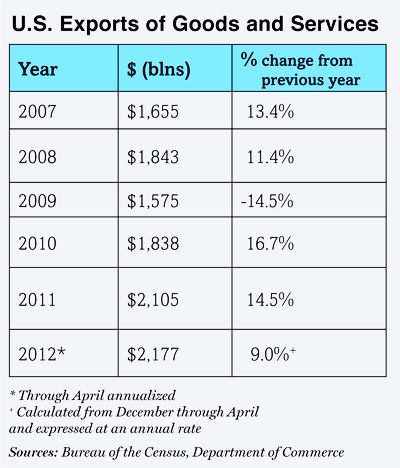 Exports have remained one of the few consistent bright spots in the otherwise sub-par U.S. economic recovery. Their growth at times has added as much as two percentage points to the pace of the economy's expansion and is a major reason why American manufacturing has staged a comeback in recent years, a "renaissance" some have called it. But of late, with the dollar rising against the euro as well as the yen and growth overseas slowing or, in Europe's case, falling, questions have arisen about the sustainability of this export strength. Doubtless, the pace of gain will slow, but growth in exports is likely to continue.
Exports have remained one of the few consistent bright spots in the otherwise sub-par U.S. economic recovery. Their growth at times has added as much as two percentage points to the pace of the economy's expansion and is a major reason why American manufacturing has staged a comeback in recent years, a "renaissance" some have called it. But of late, with the dollar rising against the euro as well as the yen and growth overseas slowing or, in Europe's case, falling, questions have arisen about the sustainability of this export strength. Doubtless, the pace of gain will slow, but growth in exports is likely to continue.
The U.S. export boom actually took off in 2007, held up remarkably well during the 2008-09 recession and has generally picked up momentum since. As the table below shows, exports of goods and services jumped 13.3% in 2007 and continued to grow almost apace in 2008, even as the global financial crisis rocked world economies. Unsurprisingly, exports fell in the global recession year of 2009, but they rebounded into 2010 and 2011 despite the disappointing pace of the global expansion. So far this year, as China reduced its overall growth expectations and Europe fell into recession, export growth has actually accelerated. Because exports amount to barely 15% of U.S. economic output, this performance, impressive as it is, could not turn a sluggish recovery into a rapid one, but it has been fast enough at times to add considerably to the pace of growth. In late 2007, net exports accounted for more than half the economy's expansion. In 2010 and early 2011, they accounted for one-third of the economy's growth.
 The expansion of the global economy, especially in the emerging world, explains some of these gains. In particular, the 2007 export jump reflected the booms occurring in China, India and other emerging economies at the time, which sucked in industrial supplies and raw materials that the U.S. economy, among others, was in a good position to provide. Of course, the global downturn in late 2008 and early 2009 helps explain the export drop in 2009, but that picture quickly changed as emerging economies resumed their rapid growth trajectories in 2010 and the early part of 2011.
The expansion of the global economy, especially in the emerging world, explains some of these gains. In particular, the 2007 export jump reflected the booms occurring in China, India and other emerging economies at the time, which sucked in industrial supplies and raw materials that the U.S. economy, among others, was in a good position to provide. Of course, the global downturn in late 2008 and early 2009 helps explain the export drop in 2009, but that picture quickly changed as emerging economies resumed their rapid growth trajectories in 2010 and the early part of 2011.
Complete your profile to continue reading and get FREE access to Treasury & Risk, part of your ALM digital membership.
Your access to unlimited Treasury & Risk content isn’t changing.
Once you are an ALM digital member, you’ll receive:
- Critical Treasury & Risk information including in-depth analysis of treasury and finance best practices, case studies with corporate innovators, informative newsletters, educational webcasts and videos, and resources from industry leaders.
- Exclusive discounts on ALM and Treasury & Risk events.
- Access to other award-winning ALM websites including PropertyCasualty360.com and Law.com.
*May exclude premium content
Already have an account? Sign In
© 2024 ALM Global, LLC, All Rights Reserved. Request academic re-use from www.copyright.com. All other uses, submit a request to [email protected]. For more information visit Asset & Logo Licensing.







